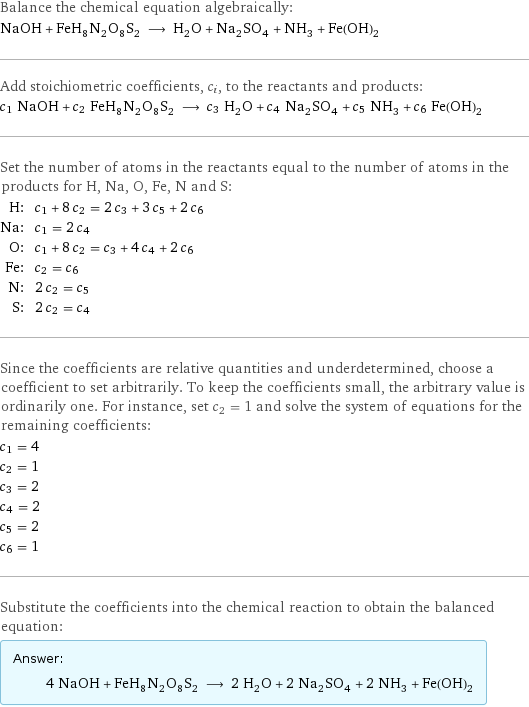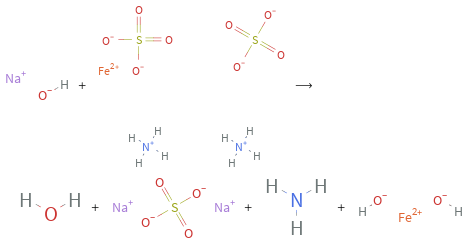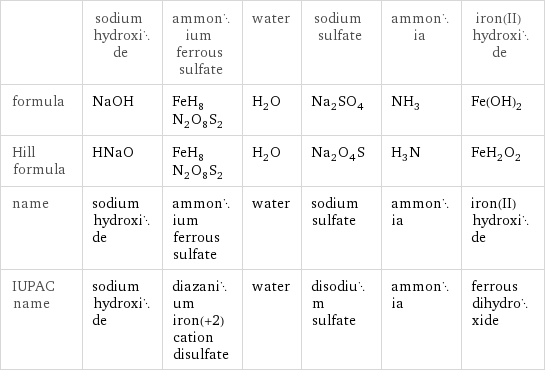Input interpretation

NaOH sodium hydroxide + FeH_8N_2O_8S_2 ammonium ferrous sulfate ⟶ H_2O water + Na_2SO_4 sodium sulfate + NH_3 ammonia + Fe(OH)_2 iron(II) hydroxide
Balanced equation

Balance the chemical equation algebraically: NaOH + FeH_8N_2O_8S_2 ⟶ H_2O + Na_2SO_4 + NH_3 + Fe(OH)_2 Add stoichiometric coefficients, c_i, to the reactants and products: c_1 NaOH + c_2 FeH_8N_2O_8S_2 ⟶ c_3 H_2O + c_4 Na_2SO_4 + c_5 NH_3 + c_6 Fe(OH)_2 Set the number of atoms in the reactants equal to the number of atoms in the products for H, Na, O, Fe, N and S: H: | c_1 + 8 c_2 = 2 c_3 + 3 c_5 + 2 c_6 Na: | c_1 = 2 c_4 O: | c_1 + 8 c_2 = c_3 + 4 c_4 + 2 c_6 Fe: | c_2 = c_6 N: | 2 c_2 = c_5 S: | 2 c_2 = c_4 Since the coefficients are relative quantities and underdetermined, choose a coefficient to set arbitrarily. To keep the coefficients small, the arbitrary value is ordinarily one. For instance, set c_2 = 1 and solve the system of equations for the remaining coefficients: c_1 = 4 c_2 = 1 c_3 = 2 c_4 = 2 c_5 = 2 c_6 = 1 Substitute the coefficients into the chemical reaction to obtain the balanced equation: Answer: | | 4 NaOH + FeH_8N_2O_8S_2 ⟶ 2 H_2O + 2 Na_2SO_4 + 2 NH_3 + Fe(OH)_2
Structures

+ ⟶ + + +
Names

sodium hydroxide + ammonium ferrous sulfate ⟶ water + sodium sulfate + ammonia + iron(II) hydroxide
Equilibrium constant
![Construct the equilibrium constant, K, expression for: NaOH + FeH_8N_2O_8S_2 ⟶ H_2O + Na_2SO_4 + NH_3 + Fe(OH)_2 Plan: • Balance the chemical equation. • Determine the stoichiometric numbers. • Assemble the activity expression for each chemical species. • Use the activity expressions to build the equilibrium constant expression. Write the balanced chemical equation: 4 NaOH + FeH_8N_2O_8S_2 ⟶ 2 H_2O + 2 Na_2SO_4 + 2 NH_3 + Fe(OH)_2 Assign stoichiometric numbers, ν_i, using the stoichiometric coefficients, c_i, from the balanced chemical equation in the following manner: ν_i = -c_i for reactants and ν_i = c_i for products: chemical species | c_i | ν_i NaOH | 4 | -4 FeH_8N_2O_8S_2 | 1 | -1 H_2O | 2 | 2 Na_2SO_4 | 2 | 2 NH_3 | 2 | 2 Fe(OH)_2 | 1 | 1 Assemble the activity expressions accounting for the state of matter and ν_i: chemical species | c_i | ν_i | activity expression NaOH | 4 | -4 | ([NaOH])^(-4) FeH_8N_2O_8S_2 | 1 | -1 | ([FeH8N2O8S2])^(-1) H_2O | 2 | 2 | ([H2O])^2 Na_2SO_4 | 2 | 2 | ([Na2SO4])^2 NH_3 | 2 | 2 | ([NH3])^2 Fe(OH)_2 | 1 | 1 | [Fe(OH)2] The equilibrium constant symbol in the concentration basis is: K_c Mulitply the activity expressions to arrive at the K_c expression: Answer: | | K_c = ([NaOH])^(-4) ([FeH8N2O8S2])^(-1) ([H2O])^2 ([Na2SO4])^2 ([NH3])^2 [Fe(OH)2] = (([H2O])^2 ([Na2SO4])^2 ([NH3])^2 [Fe(OH)2])/(([NaOH])^4 [FeH8N2O8S2])](../image_source/8cdb2e9105ad369be562d545762e7867.png)
Construct the equilibrium constant, K, expression for: NaOH + FeH_8N_2O_8S_2 ⟶ H_2O + Na_2SO_4 + NH_3 + Fe(OH)_2 Plan: • Balance the chemical equation. • Determine the stoichiometric numbers. • Assemble the activity expression for each chemical species. • Use the activity expressions to build the equilibrium constant expression. Write the balanced chemical equation: 4 NaOH + FeH_8N_2O_8S_2 ⟶ 2 H_2O + 2 Na_2SO_4 + 2 NH_3 + Fe(OH)_2 Assign stoichiometric numbers, ν_i, using the stoichiometric coefficients, c_i, from the balanced chemical equation in the following manner: ν_i = -c_i for reactants and ν_i = c_i for products: chemical species | c_i | ν_i NaOH | 4 | -4 FeH_8N_2O_8S_2 | 1 | -1 H_2O | 2 | 2 Na_2SO_4 | 2 | 2 NH_3 | 2 | 2 Fe(OH)_2 | 1 | 1 Assemble the activity expressions accounting for the state of matter and ν_i: chemical species | c_i | ν_i | activity expression NaOH | 4 | -4 | ([NaOH])^(-4) FeH_8N_2O_8S_2 | 1 | -1 | ([FeH8N2O8S2])^(-1) H_2O | 2 | 2 | ([H2O])^2 Na_2SO_4 | 2 | 2 | ([Na2SO4])^2 NH_3 | 2 | 2 | ([NH3])^2 Fe(OH)_2 | 1 | 1 | [Fe(OH)2] The equilibrium constant symbol in the concentration basis is: K_c Mulitply the activity expressions to arrive at the K_c expression: Answer: | | K_c = ([NaOH])^(-4) ([FeH8N2O8S2])^(-1) ([H2O])^2 ([Na2SO4])^2 ([NH3])^2 [Fe(OH)2] = (([H2O])^2 ([Na2SO4])^2 ([NH3])^2 [Fe(OH)2])/(([NaOH])^4 [FeH8N2O8S2])
Rate of reaction
![Construct the rate of reaction expression for: NaOH + FeH_8N_2O_8S_2 ⟶ H_2O + Na_2SO_4 + NH_3 + Fe(OH)_2 Plan: • Balance the chemical equation. • Determine the stoichiometric numbers. • Assemble the rate term for each chemical species. • Write the rate of reaction expression. Write the balanced chemical equation: 4 NaOH + FeH_8N_2O_8S_2 ⟶ 2 H_2O + 2 Na_2SO_4 + 2 NH_3 + Fe(OH)_2 Assign stoichiometric numbers, ν_i, using the stoichiometric coefficients, c_i, from the balanced chemical equation in the following manner: ν_i = -c_i for reactants and ν_i = c_i for products: chemical species | c_i | ν_i NaOH | 4 | -4 FeH_8N_2O_8S_2 | 1 | -1 H_2O | 2 | 2 Na_2SO_4 | 2 | 2 NH_3 | 2 | 2 Fe(OH)_2 | 1 | 1 The rate term for each chemical species, B_i, is 1/ν_i(Δ[B_i])/(Δt) where [B_i] is the amount concentration and t is time: chemical species | c_i | ν_i | rate term NaOH | 4 | -4 | -1/4 (Δ[NaOH])/(Δt) FeH_8N_2O_8S_2 | 1 | -1 | -(Δ[FeH8N2O8S2])/(Δt) H_2O | 2 | 2 | 1/2 (Δ[H2O])/(Δt) Na_2SO_4 | 2 | 2 | 1/2 (Δ[Na2SO4])/(Δt) NH_3 | 2 | 2 | 1/2 (Δ[NH3])/(Δt) Fe(OH)_2 | 1 | 1 | (Δ[Fe(OH)2])/(Δt) (for infinitesimal rate of change, replace Δ with d) Set the rate terms equal to each other to arrive at the rate expression: Answer: | | rate = -1/4 (Δ[NaOH])/(Δt) = -(Δ[FeH8N2O8S2])/(Δt) = 1/2 (Δ[H2O])/(Δt) = 1/2 (Δ[Na2SO4])/(Δt) = 1/2 (Δ[NH3])/(Δt) = (Δ[Fe(OH)2])/(Δt) (assuming constant volume and no accumulation of intermediates or side products)](../image_source/8f7dd4e0c74562dd3bb9713ffa02e30e.png)
Construct the rate of reaction expression for: NaOH + FeH_8N_2O_8S_2 ⟶ H_2O + Na_2SO_4 + NH_3 + Fe(OH)_2 Plan: • Balance the chemical equation. • Determine the stoichiometric numbers. • Assemble the rate term for each chemical species. • Write the rate of reaction expression. Write the balanced chemical equation: 4 NaOH + FeH_8N_2O_8S_2 ⟶ 2 H_2O + 2 Na_2SO_4 + 2 NH_3 + Fe(OH)_2 Assign stoichiometric numbers, ν_i, using the stoichiometric coefficients, c_i, from the balanced chemical equation in the following manner: ν_i = -c_i for reactants and ν_i = c_i for products: chemical species | c_i | ν_i NaOH | 4 | -4 FeH_8N_2O_8S_2 | 1 | -1 H_2O | 2 | 2 Na_2SO_4 | 2 | 2 NH_3 | 2 | 2 Fe(OH)_2 | 1 | 1 The rate term for each chemical species, B_i, is 1/ν_i(Δ[B_i])/(Δt) where [B_i] is the amount concentration and t is time: chemical species | c_i | ν_i | rate term NaOH | 4 | -4 | -1/4 (Δ[NaOH])/(Δt) FeH_8N_2O_8S_2 | 1 | -1 | -(Δ[FeH8N2O8S2])/(Δt) H_2O | 2 | 2 | 1/2 (Δ[H2O])/(Δt) Na_2SO_4 | 2 | 2 | 1/2 (Δ[Na2SO4])/(Δt) NH_3 | 2 | 2 | 1/2 (Δ[NH3])/(Δt) Fe(OH)_2 | 1 | 1 | (Δ[Fe(OH)2])/(Δt) (for infinitesimal rate of change, replace Δ with d) Set the rate terms equal to each other to arrive at the rate expression: Answer: | | rate = -1/4 (Δ[NaOH])/(Δt) = -(Δ[FeH8N2O8S2])/(Δt) = 1/2 (Δ[H2O])/(Δt) = 1/2 (Δ[Na2SO4])/(Δt) = 1/2 (Δ[NH3])/(Δt) = (Δ[Fe(OH)2])/(Δt) (assuming constant volume and no accumulation of intermediates or side products)
Chemical names and formulas

| sodium hydroxide | ammonium ferrous sulfate | water | sodium sulfate | ammonia | iron(II) hydroxide formula | NaOH | FeH_8N_2O_8S_2 | H_2O | Na_2SO_4 | NH_3 | Fe(OH)_2 Hill formula | HNaO | FeH_8N_2O_8S_2 | H_2O | Na_2O_4S | H_3N | FeH_2O_2 name | sodium hydroxide | ammonium ferrous sulfate | water | sodium sulfate | ammonia | iron(II) hydroxide IUPAC name | sodium hydroxide | diazanium iron(+2) cation disulfate | water | disodium sulfate | ammonia | ferrous dihydroxide
Substance properties

| sodium hydroxide | ammonium ferrous sulfate | water | sodium sulfate | ammonia | iron(II) hydroxide molar mass | 39.997 g/mol | 284 g/mol | 18.015 g/mol | 142.04 g/mol | 17.031 g/mol | 89.86 g/mol phase | solid (at STP) | solid (at STP) | liquid (at STP) | solid (at STP) | gas (at STP) | melting point | 323 °C | 100 °C | 0 °C | 884 °C | -77.73 °C | boiling point | 1390 °C | | 99.9839 °C | 1429 °C | -33.33 °C | density | 2.13 g/cm^3 | 1.86 g/cm^3 | 1 g/cm^3 | 2.68 g/cm^3 | 6.96×10^-4 g/cm^3 (at 25 °C) | solubility in water | soluble | | | soluble | | surface tension | 0.07435 N/m | | 0.0728 N/m | | 0.0234 N/m | dynamic viscosity | 0.004 Pa s (at 350 °C) | | 8.9×10^-4 Pa s (at 25 °C) | | 1.009×10^-5 Pa s (at 25 °C) | odor | | | odorless | | |
Units
